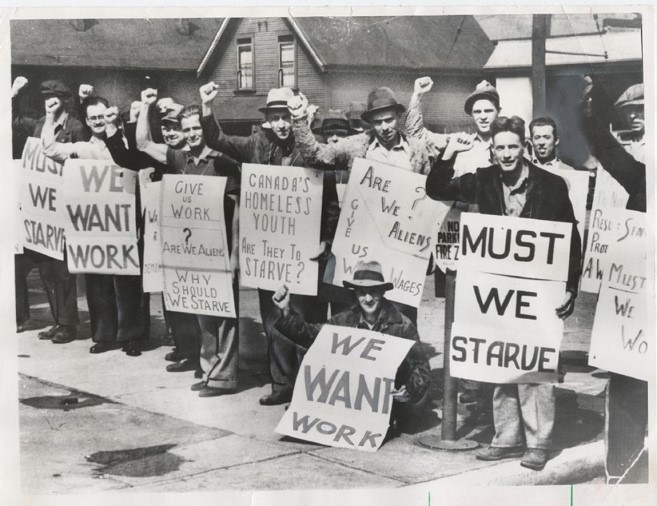Many causes led to the Great Depression in the 1930s, also known as the Dirty Thirties. The stock market crash in 1929 did not directly cause the Depression; however, it marked the beginning of the recession and led towards the “long” Depression. The Depression had six main causes that had a huge impact on both the economy and the market in the 30s.
First, overproduction and over-expansion were two of the major causes of the Depression. This happened when the products were overproduced, meaning people produced more goods than they sold. Factories were panicking about selling fewer goods than they had expected. Some manufactures lowered the price for the goods and produced fewer goods. As a lot of workers were laid off, more people could not afford to buy consumer goods, and this really affected the sales and slowed them down a lot.
Second, Canada’s dependence on a few primary products was another factor that caused the Depression. Some examples of the said products were wheat, fish, and minerals. Canada found itself in huge economic crisis as it depended largely on one primary product, which led to the Great Depression. Primary products, such as wheat, were always processed by the secondary industries. Eventually, the price of wheat started to fall, and farmers faced drought on the prairies. This hugely impacted the economy. It was really hard for the crops to grow in such bad conditions, so a lot of families had difficulty surviving. With a limited income and no wheat production, life in the 30s became very hard. All sorts of problems made by the farmers caused a chain reaction to Canada’s society.
Third, Canada greatly depended on the US during the period. About 65 percent of its goods were imported from the US, and about 40 percent of Canada’s goods were exported to the US. Great Britain was replaced by the US as Canada’s dominant trading partner and the largest buyer of Canadian products. The Americans set up a lot of branch plants in Canada to avoid huge losses in the economy. In addition, since Canada was highly dependent on the US, once the US economy collapsed, Canada economy suffered as well. This proves that Canada’s dependence on the US played a role in the Great Depression.
Fourth, high tariffs choked off the trades with other countries. Governments set up high tariffs, as they wanted to protect home industries from other foreign goods. Many countries followed suit and set up high tariffs as well, and these tariffs slowed down world trade to a great extent. For example, if the US set a high tariff on some foreign goods, then it would protect its domestic industries even if it would also result in limiting its imports. This particular trade policy is known as protectionism. As Canada greatly depended on the US, they were highly susceptible to being impacted by US trade policies.
Fifth, there was a lot of credit buying in the 30s, which also contributed to the Depression. It was very popular to have a “buy now, pay later” bill, which meant that if a truck originally cost 145 USD, then you could pay a down payment of 40 USD and pay the rest later. Usually, people do this when they do not have enough money to purchase the product in full. On the other hand, if the wage started to decrease and workers were laid off work, then people would not be able to keep up with the payment, and that had a negative effect on the world’s economy. People started losing things; a lot of products were repossessed by creditors. This was not an incorrect factor of how people treat things; however, credit buying was prevalent, and it led to the Depression.
Lastly, there was a lot of credit buying on stocks as well, which also caused the Depression. In the 1920s, the stock market was a really good and quick way to get rich. It was similar to the process of buying a product on credit, in which people often paid a down payment of about 10 percent, and the broker loaned them the rest. The purpose of this was to sell the stocks after their prices went up and to pay back the loan to the broker. This process was full of risk, and the potential of stocks going down drove people crazy. Because of this, many people were unable to settle their loans and faced financial problems. On October 29, 1929, the US stock market crashed, and it is known as Black Tuesday. In a few hours, the value of the stocks dropped by more than 50 percent. Huge money losses occurred in only a few hours, and people went broke and were unable to pay back the creditors. This painful event marked a shift of the 1920s to the crushing poverty of the Great Depression.
Overall, there were many causes that led to the Dirty Thirties. When an economic recession is longer and more severe, it often causes depression. This period of time has a huge impact on the people and the economy. After the economic problems in the 30s, recovery happened. The economy began to grow again. The Depression was really painful, and starting a war was the only way to drag the country out of the Depression. The depression was officially over when WW2 started.
“The Great Depression in Canada.” The Canadian Encyclopedia, www.thecanadianencyclopedia.ca/en/article/great-depression.
“Great Depression.” Encyclopædia Britannica, Encyclopædia Britannica, Inc., www.britannica.com/event/Great-Depression.
